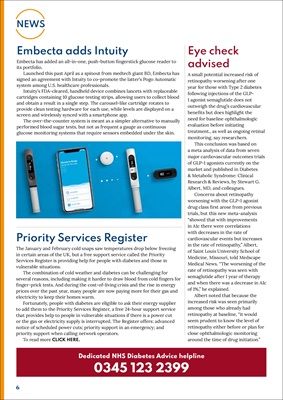
6
NEWS
Dedicated NHS Diabetes Advice helpline
0345 123 2399
Eye check
advised
A small potential increased risk of
retinopathy worsening after one
year for those with Type 2 diabetes
following injections of the GLP1 agonist
semaglutide does not
outweigh the drug's cardiovascular
benefits but does highlight the
need for baseline ophthalmologic
evaluation before initiating
treatment., as well as ongoing retinal
monitoring, say researchers.
This conclusion was based on
a meta analysis of data from seven
major cardiovascular outcomes trials
of GLP-1 agonists currently on the
market and published in Diabetes
& Metabolic Syndrome: Clinical
Research & Reviews, by Stewart G.
Albert, MD, and colleagues.
Concerns about retinopathy
worsening with the GLP-1 agonist
drug class first arose from previous
trials, but this new meta-analysis
"showed that with improvements
in A1c there were correlations
with decreases in the rate of
cardiovascular events but increases
in the rate of retinopathy," Albert,
of Saint Louis University School of
Medicine, Missouri, told Medscape
Medical News. "The worsening of the
rate of retinopathy was seen with
semaglutide after 1 year of therapy
and when there was a decrease in A1c
of 1%," he explained.
Albert noted that because the
increased risk was seen primarily
among those who already had
retinopathy at baseline, "it would
seem prudent to know the level of
retinopathy either before or plan for
close ophthalmologic monitoring
around the time of drug initiation."
Embecta adds Intuity
Embecta has added an all-in-one, push-button fingerstick glucose reader to
its portfolio.
Launched this past April as a spinout from medtech giant BD, Embecta has
signed an agreement with Intuity to co-promote the latter's Pogo Automatic
system among U.S. healthcare professionals.
Intuity's FDA-cleared, handheld device combines lancets with replaceable
cartridges containing 10 glucose testing strips, allowing users to collect blood
and obtain a result in a single step. The carousel-like cartridge rotates to
provide clean testing hardware for each use, while levels are displayed on a
screen and wirelessly synced with a smartphone app.
The over-the-counter system is meant as a simpler alternative to manually
performed blood sugar tests, but not as frequent a gauge as continuous
glucose monitoring systems that require sensors embedded under the skin.
Priority Services Register
The January and February cold snaps saw temperatures drop below freezing
in certain areas of the UK, but a free support service called the Priority
Services Register is providing help for people with diabetes and those in
vulnerable situations.
The combination of cold weather and diabetes can be challenging for
several reasons, including making it harder to draw blood from cold fingers for
finger-prick tests. And during the cost-of-living crisis and the rise in energy
prices over the past year, many people are now paying more for their gas and
electricity to keep their homes warm.
Fortunately, people with diabetes are eligible to ask their energy supplier
to add them to the Priority Services Register, a free 24-hour support service
that provides help to people in vulnerable situations if there is a power cut
or the gas or electricity supply is interrupted. The Register offers: advanced
notice of scheduled power cuts; priority support in an emergency; and
priority support when calling network operators.
To read more CLICK HERE.